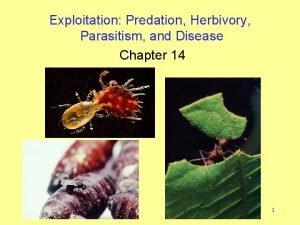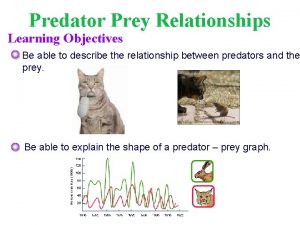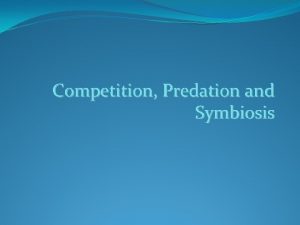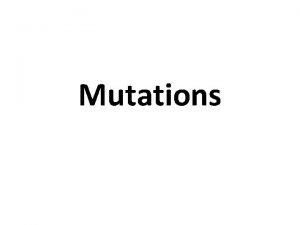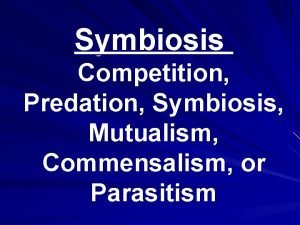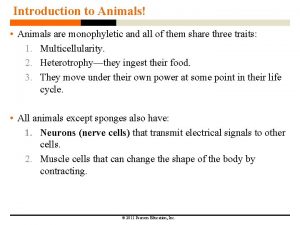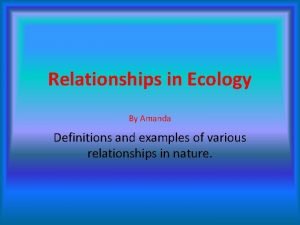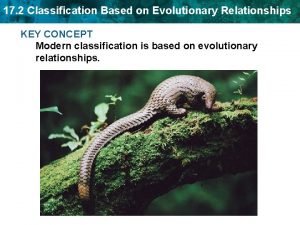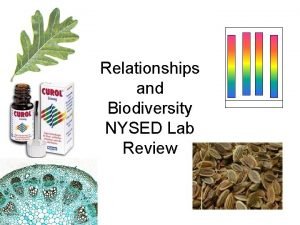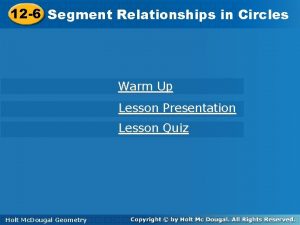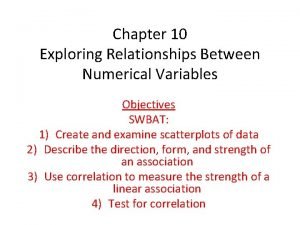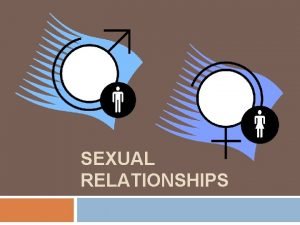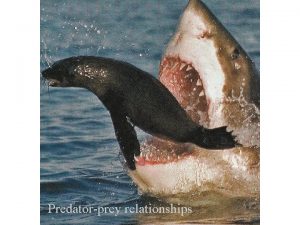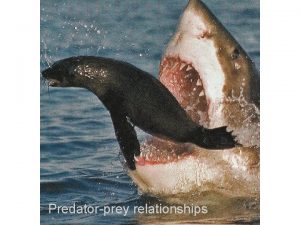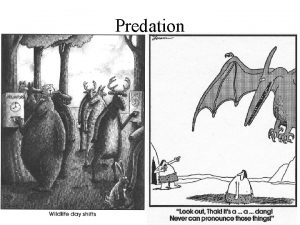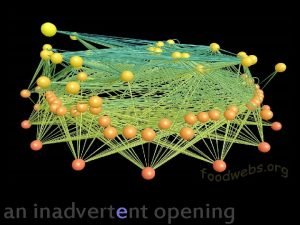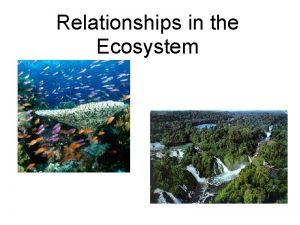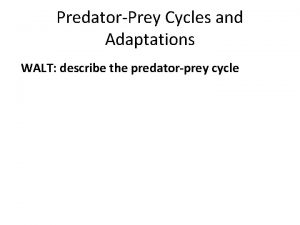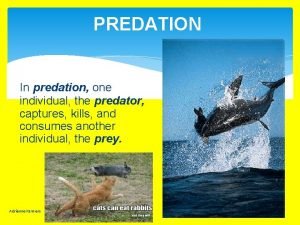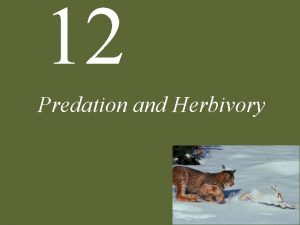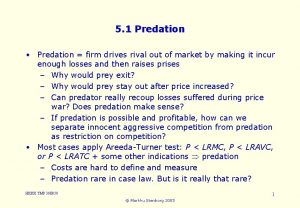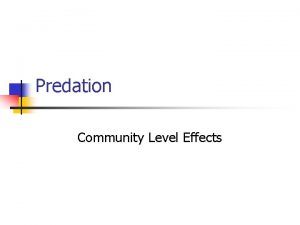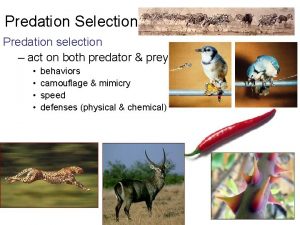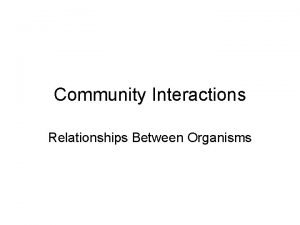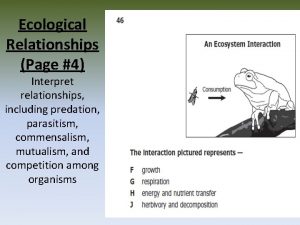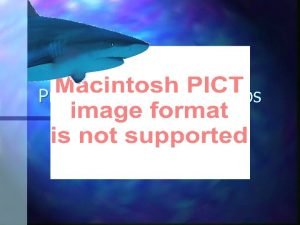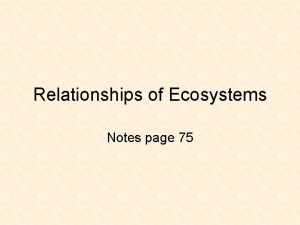Predatorprey relationships Predation is a straightforward interspecies population































- Slides: 31

Predator-prey relationships

Predation is a straight-forward interspecies population interaction. One species uses another as a food resource. Predators play an important role in controlling prey population numbers in some systems. In simple systems, the predator-prey relationship results in coupled population osscilations

Classic example of predator-prey dynamics: Canadian lynx & snowshoe hare Coupled oscillation

• prey numbers increase, predator numbers increase…to a point where the predation causes population decline in the prey item. .

• Idealized predator-prey coupled dynamics. • It is important to note that in most systems the food web- the web of interactions among species- is far more complex than just a single predator and single prey item. The relationships can become quite complex and the “coupled” nature of the interaction becomes much more vague.

In general, predator-prey relationships are much more complex than that displayed by lynx-hare oscillations. Very often, but not always, an increase in prey density results in a straight-forward increase in predator population size. In this case often, but not always, an increase in prey density results in a straight-forward increase in predator population size.

The action of predators in the face of increasing prey availability can take different forms. In the top panel, as the number of prey items (Microtus) increases, the number killed by the predator increases in a linear fashion. In the middle panel- as the density of rodents increases, the percentage of the population killed by weasels declines in a curvilinear fashion In the bottom panel, as the number of available prey items (sixth instar larvae) increases, the number of those found in the gut of the predator (bird) increases – the bird eats more- and then levels off. There are various potential explanations of this, one being that the bird population is “satiated” at certain densities.

Prey are variable in value. Don’t want to spend time & energy on prey items that are energetically expensive to process (if other options are available).

Predator-prey relationships can include: pulse, lag, response- timing

Predator-prey relationships often have ramifications for other parts of the ecosystem. The hare-lynx relationship is an example. Hares eat twigs, more hares = more damage to trees. More lynx = fewer hares and less damage to trees. Now can you answer the wolf songbird riddle?

• Predator-prey relationships are dynamic • They are influenced by climate dynamics, changes in food availability for the prey species, and dynamics in other areas of the food web (to be discussed later in the semester) • Predator-prey relationships also are dynamic through evolutionary time. • Often involve an evolutionary “arms race. ” Natural selection simultaneously driving the predators toward greater hunting efficiency and the prey toward traits that help them avoid being eaten.

Tactics of the Predator 1) Invisibility Cloak (cryptic coloration/ camouflage) http: //www. youtube. com/watch? v=__XA 6 B 41 SQQ

Tactics of the Predator 2) Patience is a Virtue (Hide and Wait)

Tactics of the Predator 3) Death by Poisoning (Venoms)

Tactics of the Predator 4) “Right this Way Please”: trap-doors, nets, and other deadly devices.

Tactics of the Predator 5) Bigger, Badder, Faster 200 mph 700 lbs & built to kill What immortal hand or eye Could frame thy fearful symmetry? William Blake http: //www. youtube. com/watch? v=DWs. N 63 PRCW 8 17, 000 lbs, and perhaps as smart as you

Tactics of the Predator Combinations- Invisibility Cloak; Patience; Bigger, Badder, Faster Dr. Laurie Marker: Dropped out of school at 20, tried to start a vineyard- discovered that wildlife conservation was her life passion, became world renown expert. www. cheetah. org

Responses of the Prey 1) Invisibility Cloak (cryptic coloration/ camouflage)

Responses of the Prey 2) FLEE!!!!

Responses of the Prey 3) Eat me and die (poisons and aposematic coloration):

Responses of the Prey 4) “Shields up”: (armor):

Responses of the Prey 5) “Who wants fetid flesh for dinner? Surely not a proud hunter like yourself” (play dead):

Responses of the Prey 6) Mimicry: Batesian mimicry- looks like a toxic model- but is non-toxic Mullerian mimicry- looks like a toxic model- AND is toxic

Responses of the Prey 6) Disguise:

Responses of the Prey 6) Strength in Numbers:

Herbivory, a special case of predation… Not really- herbivory involves the taking of plant material by an animal herbivore- is almost always non-fatal, and can sometimes be an advantage for the plant- or at least stimulate growth and promote community diversity. . . Herbivory generally becomes a problem when the ecological system is out of balance. E. g. , invasive insects (gypsy moth)- or the loss of predators (white-tailed deer)

Herbivore-plant relationships also can evolve into an “arms race” Plants evolve armor (thorns, spines, prickles), toxicity, implant cells with silica, and sometimes symbiotic relationships to defend foliage.

Plants evolve thorns, animals evolve morphology and behavioral techniques to avoid thorns. Plants get taller, change canopy structure, animals get taller.

Plants trick animals into doing their bidding: Plants want some parts eaten (fruits) for seed dispersal, only after the seed has matured (thus ripening), and plants do not want foliage eaten…

The expense of herbivore defense is only worth it if the foliage is very valuable. Plants that live it harsh conditions, can’t afford to rebuild foliage, so develop defenses. Plants that grow in lush conditions, simply outgrow herbivores.

Predator-prey relationships
 Son las siete menos veinte in english
Son las siete menos veinte in english Greedy approach
Greedy approach Literal imagery definition
Literal imagery definition Mbti loud
Mbti loud Ippississim
Ippississim Gary polis
Gary polis Parasitism
Parasitism Examples of predator animals
Examples of predator animals Commensalism and mutualism difference
Commensalism and mutualism difference Neutral mutation
Neutral mutation Weather
Weather Types of parasitism
Types of parasitism Difference between predation and parasitism
Difference between predation and parasitism Predation examples
Predation examples Predation
Predation Chapter 4 population ecology worksheet answer key
Chapter 4 population ecology worksheet answer key Population ecology section 1 population dynamics
Population ecology section 1 population dynamics Population ecology section 1 population dynamics
Population ecology section 1 population dynamics Chapter 4 population ecology section 1 population dynamics
Chapter 4 population ecology section 1 population dynamics Based on evolutionary relationships
Based on evolutionary relationships Is botana curus real
Is botana curus real Healthy relationships
Healthy relationships Managing relationship and building loyalty
Managing relationship and building loyalty 12-6 segment relationships in circles
12-6 segment relationships in circles Tropical rainforest relationships
Tropical rainforest relationships Angle relationships definition
Angle relationships definition Family of orientation
Family of orientation Relationships between two numerical variables
Relationships between two numerical variables Building customer relationships through effective marketing
Building customer relationships through effective marketing Using adverb clauses to show time relationships
Using adverb clauses to show time relationships Definition of sexuality
Definition of sexuality Vcaa respectful relationships
Vcaa respectful relationships






